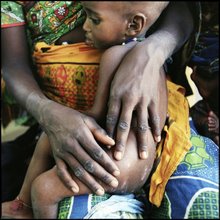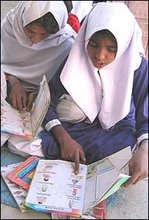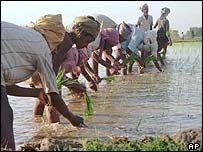PREAMBLE: Maternal Mortality represents the largest rich-poor disparity tracked by the World Health Organization. On the heels of a study recently released by the United Nations (UN), the Women Deliver Global Conference in London, 18-20 October, assessed high levels of maternal mortality round the world. Delegates learned that little progress has been made in reducing maternal deaths in many countries. Areas of major focus were South Asia, parts of Africa, and even the United States came under scrutiny, as it lags the developed world in its maternal health performance. The conference was supported by non-governmental, intergovernmental and development agencies as well as private sector and philanthropic entities aiming to create the political will to improve the health of pregnant mothers and their children, and to strengthen health systems around the world to prevent the deaths during pregnancy or childbirth of "one woman every minute of every day ".
Visit Our Sidebar, with reference to the topic: "BEYOND THOSE HEALH CARE NUMBERS - commentary on a vacuous analysis", for our views on the US need to improve its health system.
SOUTH ASIA
Status of Women reflected in Preventable Deaths: "Maternal mortality levels are a key indicator of the status of women in society. They show how well a country's health service is performing and what cultural position women hold in society," says UNICEF spokesperson Katey Grusovin. South Asia's high maternal mortality rates account for almost half of all maternal deaths globally. UNICEF says that the lack of adequate resources and knowledge not only results in preventable maternal deaths, but it severely impacts on children who are left motherless. Some studies suggest that these children are 10 times more likely than their peers to die within two years of their mothers' deaths. "In South Asia, every year around 188,000 women die from complications in pregnancy and childbirth." Several countries in South Asia are responsible for the bulk of these mostly preventable deaths: India with 117,000 annual maternal deaths, Afghanistan 26,000, Bangladesh 21,000, and Pakistan 15,000. In many countries, the majority of births occur at home in rural areas without qualified medical help.
Poor Transportation and Inadequate Service Provisions: In the region if a woman does not survive the often long and perilous journey to hospital, there is every chance there will be no doctor, nurse or anaesthetist on duty to help her, nor any drug or blood supplies available with which to treat her. "And if there are - payment for these services may be well beyond the means of the women and her family," says Grusovin.
Gender Insensitivity: South Asia has been described as the most "gender insensitive region in the world". UNICEF says that from birth women are given a smaller share of food (60% of women in their childbearing years suffer from malnutrition), a larger share of work and little or no say in their own healthcare. They are likely to marry earlier and have had little or no education and live on or below the poverty line.
The Face of Huge Economic Disparities: "Throughout the region there is a huge disparity between its desolate performance on most indicators of human development on the one hand, and the stunning economic growth and prosperity experienced in several countries on the other," a UNICEF report says. "The fact that these positive developments have failed to trickle down to the poorest sectors of society is due to a host of factors, including religious and cultural practices, political and economic exclusion and gender bias." UNICEF says that steps to tackle the problem should be simple to implement. For example, 2.3 million South Asian infants who die annually could be saved along with their mothers if obstetric care was improved.
Is a Woman’s Life Worth Saving? The experience of Kalama, a 26-year-old Nepalese woman, is typical of many. She was brought to a District Hospital with labour complications. The hospital is a 3-hour walk from her village, so she had to be carried on a stretcher. She was admitted with full dilation of the cervix. The labour was prolonged, and she did not have energy to synchronise her efforts with labour contractions. The baby had to be vacuum delivered, asphyxiated and died. UNICEF says in many hospitals of the region there are no facilities to help mothers who lose their babies at birth. Says Grusovin "These women are dying not because we don't have the means to save them, but because we (the world) have not determined whether they are worth saving."
Poverty: The continual loss of millions of women from every generation has devastating implications for surviving family members, affecting infant survival rates and forcing young girls to leave school to care for siblings. Families then sink deeper into poverty. In short, the health of the mother is critical not only to her family, but to her nation.
Sources: 1. BBC News on-line: http://news.bbc.co.uk/2/shared/spl/hi/picture_gallery/07/south_asia_fighting_maternal_mortality/html/4.stm
2. Women Deliver Global Conference: http://www.womendeliver.org/overview/index.htm
UNITED STATES
Oct 13 (IPS) - Despite its enormous wealth and advanced technology, the United States (US) lags far behind other industrialized countries, and even some developing ones, in providing health care to women during pregnancy and childbirth. The US. ranks 41st in a new analysis of maternal mortality rates in 171 countries released by the UN.
The survey shows that even a developing country like South Korea is ahead of the US. "Women are unnecessarily dying from pregnancy and childbirth complications because the U.S. is moving in a wrong direction," said Beneva Schulte of Women Deliver, a Washington-based group campaigning for women's reproductive rights and access to health care.
Based on 2005 estimates, the UN analysis suggests that one in 4,800 women inthe US carry a lifetime risk of death from pregnancy. By contrast, among the 10 top-ranked industrialized countries, fewer than one in 16,400 are facing a similar situation. The reason? According to experts, in many European countries and Japan in the industrialized world, women are guaranteed good-quality health and family planning services that minimize their lifetime risk.
Many independent experts and sympathetic legislators hold the current US public health policy responsible for its dismal record because some 47 million US citizens have no access to health insurance, most of them African Americans and other minorities. According to Congresswoman Lois Capps, a California Democrat, "Even if we have the best technology, not everyone has the access to health care."
Responding to inquiries by IPS, a US public health official identified "racial disparity" as the most significant factor underlying the high U.S. maternal mortality rate. "Black women are 4 times more vulnerable than whites," Eve Lackritz, chief of the Maternal and Infant Health branch of the Centers for Disease Control (CDC), told IPS. In Lackritz's view, obesity and hypertension are two leading causes of pregnancy-related risks in the US.
Source: Maternal Mortality Shames Superpower U.S.By Haider Rizvi http://www.ipsnews.net/news.asp?idnews=39642
AFRICA & the MILLENNIUM DEVLOPMENT GOALS:
There are 10 countries, all in Africa (except Afghanistan), where high fertility and shattered health care systems cause extreme risks for pregnant women. In Somalia, Mali, Chad, and Niger, more than one in every 15 women is likely to die of pregnancy-related causes. In Niger, one in 7 women is vulnerable to death during pregnancy.
This analysis comes at a time when many development agencies and UN officials are trying to evaluate how far the world has progressed in meeting the Millennium Development Goals (MDGs) agreed upon by the world leaders 7 years ago. When the leaders attended a summit in New York in September 2000, they agreed that the MDGs must be achieved by 2015, a commitment that included initiatives to reduce maternal mortality by 75%.
Many experts believe that nothing much has changed since then for millions of poor women with regard to economic wellbeing and access to health care. As reported by the Lancet medical journal, at the current pace, there is almost no hope that the world will be able to achieve the 75% target. Annually, about 20 million women undergo unsafe abortions, which, according to the journal, is a major factor in maternal deaths and illness.
Reproductive rights activists say that governments must take drastic steps to reverse the situation if they are serious in meeting the MDGs on reducing the maternal mortality rates in the next seven years. "We still have the situation we had 20 years ago," said Ann Starrs of the independent group Family Care International in a statement. "Half a million women die every year from the complications of childbirth."
A recent study by Harvard University professor Ken Hill found that between 1990 and 2005, maternal deaths did fall, but by less than one percent a year. Hill and many other researchers estimate that at least 10 to 20 million women suffer injuries from the complications of childbirth every year. Experts say this suffering could be easily avoided if international donors contributed just $ 6.1 billion over the next seven years. (Editorial Comment: To place this global amount in local perspective, Canada's conservative government just anounced a reduction of 1% in its Goods and Services Tax, a cut of $34 billion annually).
Sources: 1. Haider Rizvi http://www.ipsnews.net/news.asp?idnews=39642
2. The Lancet Blog. Oct 18, 2007. http://blogs.thelancet.com/archive/2007/10/12/women-deliver
FROM a Great Canadian and World Statesman
"A great gulf... has... opened between man's material advance and his social and moral progress, a gulf in which he may one day be lost if it is not closed or narrowed..."
Lester B Pearson
http://nobelprize.org/nobel_prizes/peace/laureates/1957/pearson-lecture.html
Thursday 1 November 2007
Subscribe to:
Posts (Atom)
INSPIRATIONAL WELCOME ............................... from T.S.Eliot's "Little Gidding"
If you came this way From the place you would come from... It would be the same at the end of the journey...
If you came, not knowing what you came for, It would be the same... And what you thought you came for Is only a shell, a husk of meaning... From which the purpose breaks only when it is fulfilled If at all.




















